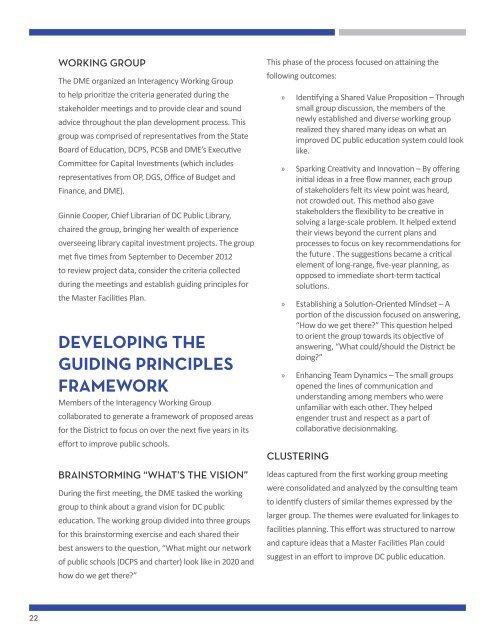DISTRICT COLUMBIA
DISTRICT COLUMBIA
DISTRICT COLUMBIA
Create successful ePaper yourself
Turn your PDF publications into a flip-book with our unique Google optimized e-Paper software.
22<br />
WORKING GROUP<br />
The DME organized an Interagency Working Group<br />
to help prioritize the criteria generated during the<br />
stakeholder meetings and to provide clear and sound<br />
advice throughout the plan development process. This<br />
group was comprised of representatives from the State<br />
Board of Education, DCPS, PCSB and DME’s Executive<br />
Committee for Capital Investments (which includes<br />
representatives from OP, DGS, Office of Budget and<br />
Finance, and DME).<br />
Ginnie Cooper, Chief Librarian of DC Public Library,<br />
chaired the group, bringing her wealth of experience<br />
overseeing library capital investment projects. The group<br />
met five times from September to December 2012<br />
to review project data, consider the criteria collected<br />
during the meetings and establish guiding principles for<br />
the Master Facilities Plan.<br />
DEVELOPING THE<br />
GUIDING PRINCIPLES<br />
FRAMEWORK<br />
Members of the Interagency Working Group<br />
collaborated to generate a framework of proposed areas<br />
for the District to focus on over the next five years in its<br />
effort to improve public schools.<br />
BRAINSTORMING “WHAT’S THE VISION”<br />
During the first meeting, the DME tasked the working<br />
group to think about a grand vision for DC public<br />
education. The working group divided into three groups<br />
for this brainstorming exercise and each shared their<br />
best answers to the question, “What might our network<br />
of public schools (DCPS and charter) look like in 2020 and<br />
how do we get there?”<br />
This phase of the process focused on attaining the<br />
following outcomes:<br />
» Identifying a Shared Value Proposition – Through<br />
small group discussion, the members of the<br />
newly established and diverse working group<br />
realized they shared many ideas on what an<br />
improved DC public education system could look<br />
like.<br />
» Sparking Creativity and Innovation – By offering<br />
initial ideas in a free flow manner, each group<br />
of stakeholders felt its view point was heard,<br />
not crowded out. This method also gave<br />
stakeholders the flexibility to be creative in<br />
solving a large-scale problem. It helped extend<br />
their views beyond the current plans and<br />
processes to focus on key recommendations for<br />
the future . The suggestions became a critical<br />
element of long-range, five-year planning, as<br />
opposed to immediate short-term tactical<br />
solutions.<br />
» Establishing a Solution-Oriented Mindset – A<br />
portion of the discussion focused on answering,<br />
“How do we get there?” This question helped<br />
to orient the group towards its objective of<br />
answering, “What could/should the District be<br />
doing?”<br />
» Enhancing Team Dynamics – The small groups<br />
opened the lines of communication and<br />
understanding among members who were<br />
unfamiliar with each other. They helped<br />
engender trust and respect as a part of<br />
collaborative decisionmaking.<br />
CLUSTERING<br />
Ideas captured from the first working group meeting<br />
were consolidated and analyzed by the consulting team<br />
to identify clusters of similar themes expressed by the<br />
larger group. The themes were evaluated for linkages to<br />
facilities planning. This effort was structured to narrow<br />
and capture ideas that a Master Facilities Plan could<br />
suggest in an effort to improve DC public education.


